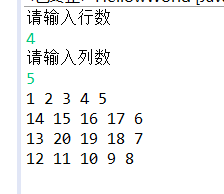
import java.util.Scanner; public class HellowWorld { public static void main(String[] argv ) { int hang,lie; //用户输入的行列数组 int total=0;//数组中总共的元素个数 int[][]decation= {{0,1},{1,0},{0,-1},{-1,0}}; //定义一个方向数组,这是方便转向的 右,下,左,上 int decationIndex=0;//方向数组的下标 初始化为向右 int row=0; //诶个填充的时候的行 int col=0;//诶个填充的时候的列 Scanner sc=new Scanner(System.in); System.out.println("请输入行数"); hang=sc.nextInt(); System.out.println("请输入列数"); lie=sc.nextInt(); total=hang*lie; int[][] arr=new int[hang][lie]; //申明二维数组 arr[row][col]=1;//第一行第一列为1 /* 填充数组 */ for(int i=2;i<=total;i++) { //确认下一个存放的数组位置 row=row+decation[decationIndex][0]; col=col+decation[decationIndex][1]; //处理下转向的问题 行是到row=lie-1的时候转,列是到hang-1的时候转,新赋值的行和列不能有值 if((row>=hang)||(row<0)||(col>=lie)||(col<0)||arr[row][col]!=0) { //回到未出界之前 row=row-decation[decationIndex][0]; col=col-decation[decationIndex][1]; decationIndex++;//转向 if(decationIndex==4) { decationIndex=0; } //新的坐标 row=row+decation[decationIndex][0]; col=col+decation[decationIndex][1]; } //将数值放进去 arr[row][col]=i; }//end for for(int i=0;i<arr.length;i++) { for(int j=0;j<arr[i].length;j++) System.out.print(arr[i][j]+" "); System.out.println(); } }//endmain, }//endclass
方法二:
public static void main(String[] args) { Scanner sc=new Scanner(System.in); int m=sc.nextInt(); int n=sc.nextInt(); int[][] arr=new int [m][n]; //二维数组 arr[0][0]=1; int cir=0;//有几个圈 int row=0; int col=0; for(int i=2;i<=m*n;i++) { if(row==cir&&col<n-1-cir) //向右 { col++; } else if(col==n-1-cir&&row<m-1-cir)//向下 row++; else if(row==m-1-cir&&col>cir)//向左 col--; else if(col==cir&&row>cir+1)//向上 完成一圈 row--; else { col++;cir++; } arr[row][col]=i; } for(int i=0;i<m;i++) { for(int j=0;j<n;j++) { System.out.print(arr[i][j]+ " "); } System.out.println(); } }